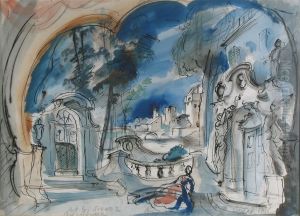Carl Josef Pollak Paintings
Carl Josef Pollak was an Austrian artist, born in 1868 in Vienna, Austria. His life spanned a period of significant artistic and political upheaval in Europe, which influenced his work and career. Pollak is often remembered for his contributions to the Viennese Secession movement, an art movement that sought to break away from the traditional academic art of the time. Although Pollak's name may not be as widely recognized as some of his contemporaries, his work played a crucial role in the development of modern art in Austria.
Pollak's artistic journey began at the Academy of Fine Arts Vienna, where he was trained in the traditional academic style. However, like many artists of his generation, Pollak became disillusioned with the conservative nature of the art establishment. This disenchantment led him to explore new forms of expression, eventually aligning himself with the Secession movement. The movement was characterized by its embrace of artistic freedom and experimentation, qualities that resonated with Pollak's evolving aesthetic sensibilities.
Throughout his career, Pollak experimented with various mediums, including painting, sculpture, and graphic design. His work often reflected the socio-political tensions of his time, imbued with a sense of modernity and a break from the past. Despite his innovative approach, Pollak faced challenges in gaining widespread recognition, overshadowed by more prominent figures of the Secession movement, such as Gustav Klimt and Egon Schiele.
Carl Josef Pollak's contributions to Austrian art were not limited to his own creations. He was also an influential figure among his peers, encouraging experimentation and the exploration of new artistic forms. Pollak's legacy is marked by his commitment to innovation and the role he played in shaping the direction of modern art in Austria.
Pollak's life and career came to an end in 1928 in Vienna. Though he did not achieve the same level of fame as some of his contemporaries, his work continues to be appreciated by art historians and collectors. Pollak's art is a testament to the vibrant artistic scene in Vienna at the turn of the century and serves as a reminder of the importance of pushing the boundaries of traditional artistic expression.
